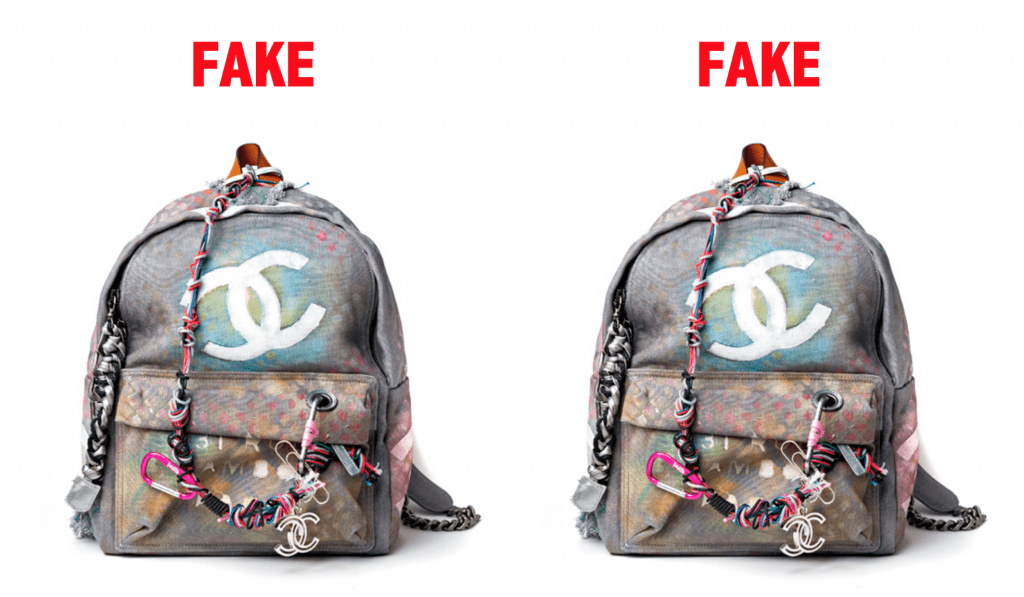This summer, the U.S. government came into possession of 22 massive shipping containers filled with counterfeit designer goods. Acting upon information gained from a 6-year-long investigation into a sophisticated and elaborate scheme that stretched from China to the U.S. and involved at least 33 different men and women, the Department of Homeland Security seized tens of thousands of Gucci, Hermès, Louis Vuitton, Chanel, and Burberry-branded products that would have been worth more than a half a billion dollars if authentic and sold at retail. It was one of the largest counterfeit seizures by U.S. Homeland Security in history.
The high-stakes fight against fakes is hardly just a government game, though. The very brands whose names were emblazoned on handbags, eyewear, and shoes and shipped across the world this past summer before ending up in the hands of the U.S. government – and all of the other brands in their esteemed ranks – have been diligently engaging in anti-counterfeiting activities for almost the entirety of their existences.
Brands allocate – and oftentimes actually spend – millions of dollars every year on legal counsel and brand protection efforts with ultimately one goal in mind: ensuring that their wildly valuable intellectual property rights are not diminished (due to saturation of the market with low-cost, low-quality counterfeits) so that they can continue to operate in the luxury sphere and charge luxury prices for their offerings (and in many cases, please their shareholders).
As brands have become increasingly more protective and government agencies more determined to intercept shipments of fakes, the number of headline-making seizures is steadily multiplying. From a brand protection standpoint, each big bust equates to success.
Burning Bags and Shredding Shoes
There is an underbelly to the fight against fakes, one that is taking an enormous social and environmental toll every time a shipment is confiscated. Each year, tens of millions of perfectly wearable and carry-able counterfeits – such as those 22 shipping containers-worth of fake Birkin bags, Louboutin heels, and Nike sneakers – are left in the custody of brands and government agencies.
Almost always, these goods – no matter how high quality, utilitarian, or otherwise attractive they may be – are destroyed, either by incineration or industrial-strength shredding.
“They’re counterfeits — what else can we do with them?,” John Sandweg, the former acting director of the federal Immigration and Customs Enforcement division, told the New York Times several years ago, discussing the fate of counterfeits after their initial confiscation and once legal proceedings have concluded; a final judgment from a court is required before counterfeit goods may be disposed.
“We are required to destroy [counterfeits] by law,” he says.
Various well-established domestic and international statutes, as well as international trade treaties, such as the Agreement on Trade-Related Aspects of Intellectual Property Rights, contain language that makes the destruction of counterfeits permissible. However, Sandweg was not referencing just any intellectual property law or trade treaty. He was referring to a specific one, a relatively new law, the seeds of which were planted as Hurricane Katrina was approached the Gulf of Mexico in August 2005.
Goodwill-Gone-Bad
On the heels of the Category 5 hurricane that wreaked havoc and death upon Florida, Louisiana, and eastern Texas almost 14 years ago, U.S. Customs and Border Protection wanted to help. So, those in the ranks of the government agency looked to the array of domestic warehouses entirely filled with previously-seized counterfeit garments and footwear, and they had an idea. Customs could provide tractor-trailers full of counterfeits to the Red Cross for distribution to individuals in the areas affected by the hurricane. And that is precisely what they did.
There was a problem almost from the outset. The government agency sidestepped the standard practice requirement that it obtain authorization from the brands whose trademarks appear on the counterfeit goods and that it remove all protected brand names and logos from the products before distributing them. Citing its “emergency authority and a presidential proclamation,” Customs donated hundreds of thousands of garments, footwear, and accessories, among other types of goods, to the Red Cross without notifying the rightsholders or de-branding any of the goods.
What would immediately follow from this seemingly grand act of goodwill was likely not what one might expect. It was not long before big-name brands started to call foul, dismayed and enraged that their carefully-protected and vigilantly-maintained intellectual property was disregarded by the U.S. government, and their legal rights as the holders of that intellectual property were violated.
More than merely shout out in rage, big brands took a step further and lobbied Congress – by way of their trade organizations, such as the AntiCounterfeiting Coalition (“IACC”), whose members include Nike, Calvin Klein, Burberry, and Rolex, among others – to ensure that this never happened again.
Less than a year later, in March 2006, President George W. Bush signed into law H.R. 32, the “Stop Counterfeiting in Manufactured Goods Act.” Considered “the most significant anti-counterfeiting legislation in more than 20 years” by the IACC, the law added, among other things, a provision requiring mandatory destruction of counterfeit goods to the federal criminal counterfeiting statute. This was a big win for brands.
However, at least some brands and organizations were necessarily content with the new status quo, which sees the burning hundreds of millions of fake products each year, and they are doing their part when their own efforts – as opposed to government operations – lead to the seizure of fakes.
Tommy Hilfiger, for instance, has worked with a British charity, called HIS Church, for years to ensure favorable handling of the counterfeit products that its in-house efforts uncover. Rather than turning the fake branded garments and accessories over to law enforcement or another government agency, Hilfiger enlists British non-profit organization HIS Church to “de-brand and rebrand” the counterfeit goods so that they can be released back into the market – or more specifically, distributed to those in need – without diluting the strength of the New York-based brand’s trademark rights.
The National Football League, which experiences a routine surge in fakes each year leading up to the Super Bowl, has taken to donating counterfeit clothing to humanitarian organizations outside of the U.S., where there is less risk of its brand being damaged by unauthorized replicas of its intellectual property.
Yet, in the upper echelons of the fashion industry – and amongst fast fashion retailers, such as H&M – the attitude towards destruction as a practice has been slow to change. As the New York Times documented, Nike came under fire in 2017 after trash bags filled with pairs of shoes, brand new-with-tags, slashed from heel to toe to prevent them from being worn were discovered on the curb of their Soho, Manhattan store.
More recently, Burberry confessed that it has been destroying millions of dollars of unsold products, a practice is has since sworn off. Still yet, Richemont, the parent company to watchmakers Cartier, Piaget, Baume & Mercier, and Vacheron Constantin, among others, made headlines last year for “allegedly destroying its expensive, unsold watches.”
If this is how some companies treat authentic products in furtherance of an effort to “prevent expensive brand-name products from entering society at low or no cost” or to ensure “their products [are not] worn by people who are obviously unable to afford them,” there is undoubtedly a whole lot more room for growth when it comes to the disposal of fakes in ways that are ethical and environmentally sound, while still recognizing brands’ intellectual property.
HIS Church, for one, hopes that more brands and law enforcement – Manchester, Liverpool, and London Police, among others, turn their sized goods over to the organization – will follow in the footsteps of the ones it works with, not only to provide assistance for those in need but to potentially eradicate some of the environmental damage that inevitably comes with the large-scale destruction of fakes.














